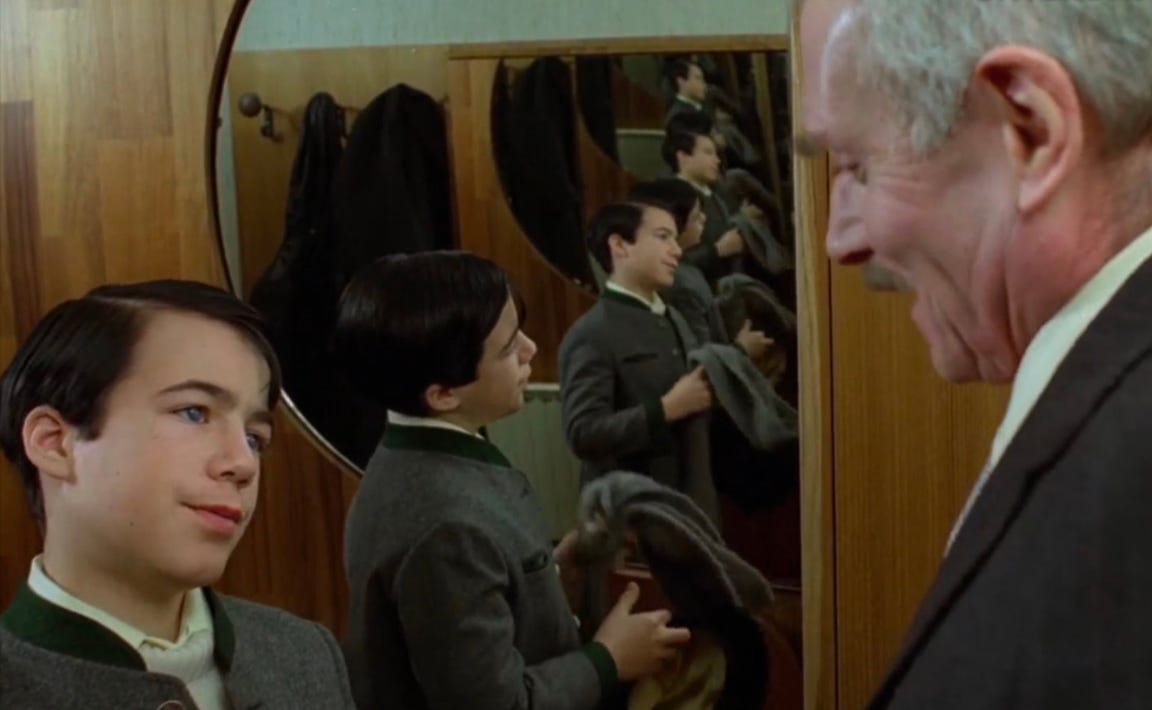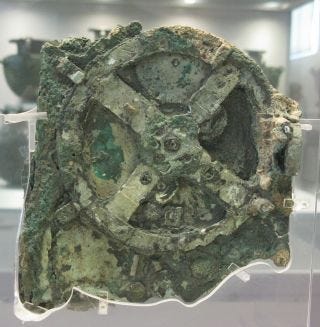Pauline Kael was, as a critic, an early-adopter of Spielberg movies; their wit and invention were too manifest for her to be a snob about. Nevertheless she wrote that Indiana Jones and the Raiders of the Lost Ark was “so thrill-packed you don’t have time to breathe—or to enjoy yourself much, either. It’s an encyclopedia of high spots from the old serials, run through at top speed and edited like a great trailer.”
Did Spielberg ever read her review? I wonder, because he seems to have turned its critique into his MO for Indiana Jones. Advising James Mangold, who took over directing the new instalment, The Dial of Destiny (as in, destiny calling!) he told him to remember, “It’s a movie that’s a trailer from beginning to end.”
But a trailer for what? Scarcely any more those old serials, nor itself, nor even the franchise (Disney has just shelved plans for an Indiana Jones TV series). The trailer is more for what it’s shown is possible, what the new film means for film, perhaps its destiny…
What do you call those stupid fins on the back of a sports car? Those ahead.
On Moon Day, when everybody else around him is celebrating the brave new world of successful lunar travel, Henry Jones Jr, a.k.a. Indiana, is retiring from being a professor. He was no longer teaching at the leafy, Ivy-leagueish Marshall College (where last we saw he’d been made Assistant Dean) but at public university in New York City. Gone his well-appointed Connecticut home in place of a scuzzy apartment next door to hippies. Gone too Marion Ravenwood (Karen Allen), who we met in the first film and he married in the last; halfway through the new one, we learn the reason for their divorce: their son Mutt (Shia LaBoeuf) dying in Vietnam. Indy’s life of adventure appears to have concluded on a tragic, lonely, and boozy note.
Cue a young woman sidling up to him in a bar: his god-daughter Helena Shaw, played by Irn Bru-reviler Phoebe Waller-Bridge. She’s a gender-swapped Belloq from Raiders with added scruples, more Vash than Lara Croft, a black-marketeer of relics like some expert from Dark Antiques Roadshow. But to Indy she claims she wants to fulfil her father’s archaeological obsession of locating the Antikythera mechanism. A real-world relic of mysterious purpose, the Antikythera in the story was invented by Archimedes to predict astronomical events, and half of which was last in the possession of Indy and Helena’s father (Toby Jones) during the Second World War.
The film begins at that war’s tail-end, with a forty-something Indy boarding a Nazi loot train, where he purloins the incomplete Antikythera back from Jürgen Voller (Mads Mikkelsen), a Nazi physicist. Like many of his kind, Voller escapes post-war Germany and justice by being Operation Paper Clipped to the US to win the space race. Now that’s done he has his sights on the final frontier. He believes the Antikythera doesn’t just predict astronomical events but fissures in time.1 Like Indy, he is filled with regrets for the past but unlike him he can do something about it: fly a plane through one of the fissures to go reverse the fortunes and glory of the Nazis. Yet not, as Indy accuses, by eliminating Churchill or FDR but Hitler. Whaaaa? Only so he can take Hitler’s place then, armed with the benefits of hindsight, win a do-over of the Second World War.
(Always with the going back in time to kill Hitler, usually expressed with a fishy over-enthusiasm. Aren’t there alternatives to that alt-history? I dragged one out of the potential in ‘Alf’.)
The Dial of Destiny, then, is about what to do with the weight of the past: fix it or give in to it, accept the wages of time—within the story, for the elderly Indiana Jones, and metatextually, for the forty-something franchise. But since this is what the film’s about there is something not quite right about it.
Talk of a story’s ‘theme’ is to my mind too close to the inane idea of its ‘message’ or that culture-chitchat question, ‘What’s your story trying to say?’ It’s better to think of what overall principle the story is designed around. That way you can better appreciate the tight- or looseness of said design.
A tighter version of The Dial of Destiny, for example, would have integrated the above-sketched ‘about’ into each beat of its plot and detail of presentation, would’ve more starkly paired Indy and villainous Voller, with their separate but parallel regrets. And it wouldn’t have been so coy about the villain’s evil plan.
James Mangold - director of the underrated Knight and Day and overrated Logan - and his writers are so chary of their time travel plot device that they don’t reveal it till late. Which could’ve worked had they not let you figure out where the film was headed long before our heroes via Voller’s insinuations about what you’d conquer next after space, and had they given him a red herring plan. Such as making out the film is a Boys from Brazil-style story, with a German scientist collaborating with fled Nazis lurking in South America to reignite the fascist cause, like ex- and neo-Nazis tried and failed to do in Bolivia, except in this film’s case aiding their cause with an ancient relic like their forebears would’ve done had they kept their hands on the Ark of the Covenant or the Holy Grail. This would’ve better set up the twist that the film’s Nazis were more than LARPers but real revanchists, off to travel time and even-more-grittily reboot the Second World War.
Instead, with our present moment’s presentist narcissism, the villain is less an ex- or neo-Nazi than a proto-member of the alt-right. He predicates his evil plan, as he monologues to Indy, not on some grand thousand-year scheme or cultic Positive Christianity but on his resentment that old white men like Indy and himself don’t get enough respect—a weird sentiment for a man in 1969 and one whom the film shows has the ear of the President and his own militia.2
Compare The Dial of Destiny with another Hollywood movie about an iconic hero confronting ageing, decline and death: Star Trek II: The Wrath of Khan. It’s formed around that confrontation from the get-go: Captain Kirk begins in reading glasses and old age aches, and ends as witness to a death not confronted but embraced for the greater good by best pal Spock. Whereas The Dial of Destiny’s Logan-like, Logan-lite story of a hero in decline doesn’t lead heavily enough with loss.
But the film was always going to be hampered designing its story around a loss it could only refer to obliquely for reasons outside the story. Shia LaBeouf, who’d previously played Indy’s lovechild Mutt, said at a press conference for the Wall Street sequel what everyone thought about Indiana Jones and the Kingdom of the Crystal Skull too early. Spielberg told him “there’s a time to be a human being and have an opinion and there’s a time to sell cars”; Harrison Ford told him he was “a fucking idiot.” Suffice to say he does not appear in the new film, his character killed off before the main plot starts. But we only learn this through an off-screen mention on the news forty minutes in, and learn that Mutt’s death was why Indy lost his marriage two thirds of the way through the film when he confides in Helena. Mutt doesn’t even appear as a pined-over photograph like Indy’s dad and Marcus Brody before him. Better writers have struggled worse to write around then write in the absence of a main character from their long-running series. This struggle, this strain is fatal for the film.
It starts confidently. Mangold hasn’t lost his nerve in replacing Spielberg, his film isn’t anxious about being an Indiana Jones film, that is a film like a trailer, that’s “always moving” to continue Spielberg’s advice from above. Its opening sequence where the younger Indy escapes hanging only for his noose to get tangled with a dud Allied bomb coring its way through the rafters has the madcap, Wallace and Gromit energy of the best of the series. Aboard the Nazi loot train, Indy’s recurring disguise of a Wehrmacht uniform gives the game away this time when a real German soldier notices the bloodied bullet hole on its back then its front, a visual gag straight out of Ernst Lubitsch. And the opening hinges on a clever self-reflexive joke: the ancient relic the Nazis have looted, the Holy Lance of Antioch that pierced Christ’s side, turns out to be a fake. A fake twice over: it’s a fake-out, a false McGuffin to the Antikythera’s real one (confirming the shift from the original trilogy’s religious dimension to the newer films’ science fiction one).
Moving to its main, 1969 time-frame, the film keeps up the playfulness. In Charlie Kaufman’s film Adaptation his alter-ego, played by Nicholas Cage, listens to his nice-but-dim screenwriter twin Donald pitch a motorcycle chase: “So the killer flees on horseback with the girl, the cop’s after them on a motorcycle and it’s like a battle between motors and horses, like technology versus horse.” The Dial of Destiny turns Donald’s pitch into reality with Indy on horseback outrunning a motorcycle and subway train. It seems as though Mangold took Pauline Kael’s point about her fave of the original trilogy, The Temple of Doom:
The whole movie is designed as a shoot-the-chutes, and toward the end, when the heroic trio… are trying to escape in a tiny mine car, and a shift in camera angles places us with them on a literal rollercoaster ride, the audience laughs in recognition that that’s what we’ve been on all along. Yet Spielberg seems relaxed, and he doesn’t push things to frighten us. The movie relates to Americans’ love of getting in the car and just taking off—it’s a breeze.
Instead, from here on in, the film’s breeziness is overwhelmed by anxiety about its existence.
Milan Kundera said that in art only the necessary has the right to exist. Whereas Paul Verhoeven when asked by The New York Times whether his sex scenes were necessary, laughed that, “Nothing is necessary in movies.” The truth lies in the contradiction: the best art is at once pointless, not for anything, but at the same time seems essential, inevitable. One way of defining a great artwork is that, while maintaining Wittgenstein’s reminder that “Whatever we see could be other than it is,” this contingent structure and pattern of details is best this way, would only be diminished if any of it were otherwise.
Now, another Indiana Jones film in 2023 is far from necessary. But I’m not gonna be so boring as to say it was only made for money or for Disney to test out the long-term viability of an IP they bought for a fortune. It was also made out of a desire for endings, to a story and to a creative project of Spielberg, George Lucas, Harrison Ford et al, for artistic closure towards the end of their careers (and, to be honest, their lives).
What this means (although suitably for a film about time travel) is that The Dial of Destiny awkwardly straddles the past and future. All these late-in-the-day sequels - the fail-and-fail-again Ghostbusters ones, the perennial Batmen - strain to get right the pander-ratio: not to do with numbers of endangered bears but whether the latest film in a franchise can be familiar enough to muster its old audience while remaining novel enough to warrant being made.
The original trilogy was an 1980s riff on 1930s serials; the fourth film on 1950s B-movies. The fifth film is a riff on Indiana Jones films. If, like Spielberg said, these films are trailers, one thing the new film is a trailer for is the old films. Which doesn’t have to be a problem; the best joke in the original trilogy was the po-mo paradox of having Indy fail to pull off his pistol-versus-swashbuckling-sabre move in The Temple of Doom like we remember he’d done in Raiders of the Lost Ark even though the sequel was in fact a prequel.3
But in The Dial of Destiny the high spots of the original films reappear less as callback jokes than obediently ticked-off boxes. Following the killer ants, sewer rats, hall of bugs and well of snakes, the film tries to give us the willies with a shipwreck of eels. (It also gives us another hall of bugs.) When Indy tries to spook Helena with what happened when the Nazis opened the Ark of the Covenant, he stands in front of the sort of lamppost that him and Marion were tied to during it, though for some reason this lamppost is on the deck of a boat. This formulaicness is why Indy has to wear his superhero costume of whip, leather jacket and fedora—even though it’s a look he got in 1912 from the grave-robber in the prologue of The Last Crusade, and which by 1969 would be as dated as the hero of a film set in 2023 wearing a velvet vest.
As for Indy’s fedora: what began as a Buster Keaton-ish gag in the first film, him snatching his hat before the trapdoor closes, has become a motif. The hat, who puts it on, takes it off, who else might pick it up, is a visual metaphor for the film’s indecision about legacy, to the point of silliness. As Gabriel Byrne said in Miller’s Crossing, “There’s nothing more foolish than a man chasing his hat.”
And it’s that indecision that musses the film’s ending. At first it teases a formally pleasing one: that Indy, wounded in the climax set during the 212BC Siege of Syracuse, will stay in the ancient world, to live or die there and in any case become an archaeological relic himself. (And, in a little time travel loop, inscribe on the Antikythera a message to his future self to tell Marion he loves her and Mutt not to enlist.) But the film doesn’t end there—Helena punches out Indy and drags him back to the future where she reunites him with Marion. By all accounts the filmmakers bottled it: Harrison Ford said the Marion reunion scene was the last they shot, while John Williams said he was called back to compose additional music, both of which suggest a revised ending. But the film’s appended restoration scene is one the franchise had given us before.
Spielberg had already expanded the original trilogy with not one but two sequels: one in spirit, the Edgar Wright and Joe Cornish-penned Tintin, and 2009’s Indiana Jones and the Kingdom of the Crystal Skull. The latter’s denouement concluded with, as comedies do, a knot-tying: Indy and Marion’s wedding. If The Dial of Destiny is about living with the past and not trying to rewrite it then it’s ironic the film is such a do-over of its predecessor. But then all the main players have since admitted what Shia LaBeouf said: that Kingdom of the Crystal Skull hadn’t been a worthy ending to the series. They were all too harsh; it’s not half as bad as everyone thinks.
‘Nuke the fridge’ is the bozo catchphrase come to stand for everything wrong with the film: in particular the last beat of its opening sequence, in which Indy survives an atomic bomb test by sheltering inside a fridge. But the actual construction of the sequence is delightful: Indy walking out of the desert seemingly back into the oasis of civilisation. The creepy Prisoner-style toy-town emptiness of it (Harrison Ford is rarely talked about as a comic actor but his terror-stricken slapstick here is pure Chevy Chase). Then our realisation a smidge ahead of Indy of where he’s stumbled upon, converging with the corroborative, never-not-chilling wail of an air-raid siren. Indy’s total WTF-do-I-do? panic, the camera pan past the fridge, the glimpse of its door label telling us it’s lead-lined, Indy almost failing to shut himself in because the door catches on a grapefruit, the instant thermonuclear melting of the town’s dummies. Sure the CGI on the shock-tossed fridge isn’t great but Indy cresting a hill silhouetted before a mushroom cloud is (which image should’ve been when we got the film’s title card, and the earlier proposed one at that: Indiana Jones and The Destroyer of Worlds).
Watch the film without sound to see how fluent Spielberg remains with framing, blocking and camera movement; the film is nothing if not directed. Note the character-detailing choreography in Mutt stealing a beer then Indy putting it back without him noticing, while neither of them knows that this fatherly gesture presages their actual relationship.4 The entrancing crystal skull isn’t the coolest of relics but the totalitarian spin the filmmakers put on it is clever, the way it makes the film’s 50s milieu of the Red Scare come true, what with Irina Spalko(Cate Blanchett)’s plan to use the skull to brainwash the masses and bodysnatcher-style replace Americans with their inner communist. And the skull originally belonging to a species of alien archaeologists is a neat touch too.5
This isn’t to say it’s a good film. From when it moves to Peru onwards it’s pretty much out of charm (except for Indy’s lovable grin at being reunited with Marion). The plot is plodding, most of it explained in motion and retroactively. And despite intentions to use practical effects, the film is caked in already-stale CGI. The waterfall drop and jungle chase sequences have the mirthless cartooniness of a Star Wars prequel. (‘Swinging with the monkeys’ deserves to be the better slogan for the film’s failure.) And its money-shot special effect - a flying saucer’s whirlpool exit from our dimension - reminds us of the cheap special effect vortex at the climax of Indiana Jones-rip off The Mummy Returns. Talk about making an undignified spectacle.6
There is a special effect, though, in the new film worth keeping an eye on. One that jars with The Dial of Destiny being a half-assed do-over of a film supposedly against the urge to do over, and that jars with its story of coming to terms with age: the special effect of de-aging.
Over the past fifteen years, digital de-aging has given us this rubbery rogues’ gallery:
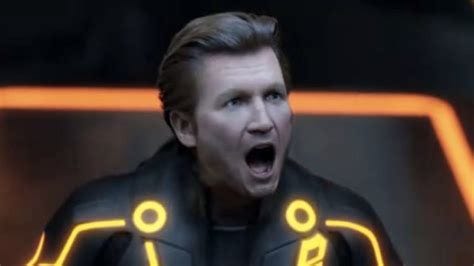
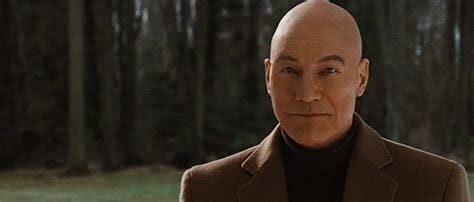
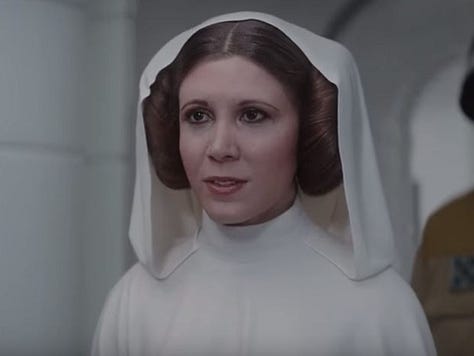
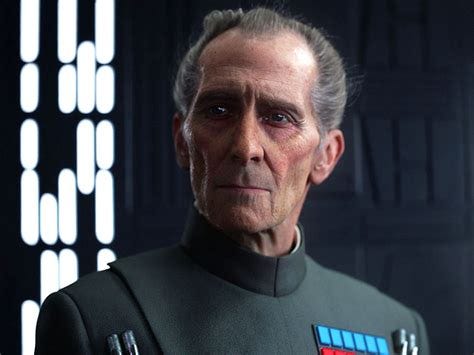
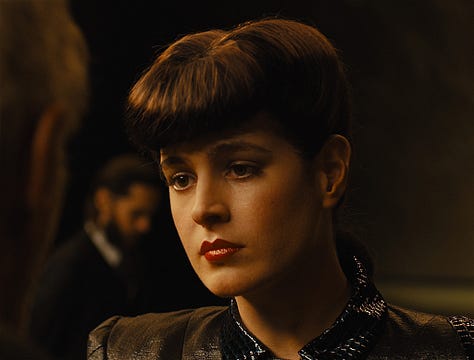
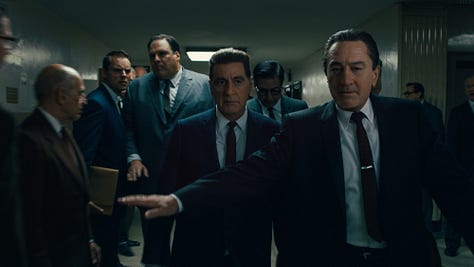
Is there a progression at least? Of Carrie Fisher and Peter Cushing in Rogue One I argued, “We’re still in the uncanny valley, but climbing up a slope.” Whereas by the time of the multiply replicant Rachael in Blade Runner 2049 I claimed we were, “over the hill”. But what looked near-real in 2017 already looks now like what it really is: animation. As I write in a feature on James Cameron, “the uncanny valley will always have a vanishing point.” Consider this:
There’s still a fuzziness and glassiness to youngified Indy, as though his face has been embossed or indented to give an illusion of relief. And the filmmakers don’t seemed to have de-aged Harrison Ford’s voice in tandem: it sounds like he’s dubbed old footage of himself with his present gravelly growl and none of the nasal twang he still had in the contemporaneous The Fugitive.
Still I wonder. The ever-better, if never-perfected digital animation of movie stars might be what The Dial of Destiny is a trailer for, a proof-of-concept of the endless iteration of the past, all under the guise of a story about not living in the past or rewriting history (Harrison Ford refused to dye his hair for the last sequel, and in this one his character complains about crushed vertebrate). The film’s not a swansong, it’s a herald.
Hasn’t this always happened with movie stars, haven’t they always de-aged themselves? When Marion reappears at the end of The Dial of Destiny I don’t think it’s irrelevant to comment (and I’m not judging, only observing) that she might have had plastic surgery. What is digital de-aging but a more reliable way to prolong Hollywood actors’ usability?
And haven’t iconic characters always had a kind of iterative immortality? Geekier fans always want to see more of their heroes, as far back at least as the first modern superhero Sherlock Holmes. (Everyone from P G Wodehouse to Kareem Abdul Jabbar have written a Holmes story). And what about those estate-approved resurrections of Raymond Chandler’s Philip Marlowe or Ian Fleming’s Bond? As a friend once said, asking when there’ll be a last James Bond is like asking when there’ll be a last Mars Bar.
But this isn’t the same as a fictional character being written by new authors or reused as a trope. And it’s certainly different to our desire to re-read and reference our heritage of myths. The immortals in them never had the one look.
The look of familiar Hollywood actors and the characters they’ve played is the aspect that’s immortal now—the mask, not the part. The dialled destiny of the new Indiana Jones is eternal digital servitude of the image. Which is neither good nor bad, reactionary nor inventive, realist nor phoney but how it’s used. We might get more witty bonanzas like Who Framed Roger Rabbit?. Or we might get Ready Player One forever. (Or SeinfeldVision! - once more the show 30 Rock has predicted the future.)
What The Dial of Destiny is really about, what is behind its seeming story about accepting obsolescence is the future it prefigures: the way that all films in the future may well become animation. James Cameron was reluctant to call his first Avatar animation but by the sequel he was admitting it. The general idea is that digital animation is just another and inevitable expansion of the filmmakers’ toolbox.
But we can’t look at both live-action films and animations purely in terms of their audiovisual info end-result. The means of their creation is relevant to that end. Not in any sense that one is pure and raw while the other is more artificial. It’s all artificial, and some of the greatest films ever made were animations. (Only card-carrying Difficult Children like Lars von Trier and his pretentious mentor Jørgen Leth would say they hate animation.)
If films do become animation, the element which photography as an aesthetic brought to film - which was not nothing, you don’t need to be Susan Sontag to appreciate the uniqueness of the value of the photographed image - might be lost. The illusion that depended on us, the audience, to blur still images flickering in fast succession into motion will be replaced by something different.
Animation is a different contract with the audience, a different kind of illusion you’re being invited to join: it’s like the difference between watching theatre and reading a comic, between playing make-believe and recreating from scratch. Even with photographed/filmed actors, part of our response draws from a similar immediacy to what people would’ve felt in theatres at the time of Archimedes and before. (Whereas the de-aged Indy never existed: it’s an AI-powered composite.) Because in a way all live-action films are stunt performances, not just the ones with boulder-dodging and chasm-leaping. If and when all films become a sort of animated recycling, will we miss that past, feel any sense of loss? Will we want to fix it?
Since for the last film George Lucas broke the silly-seal with aliens, time travel seems fair game now.
The film is diffident as well about too strongly analogising Voller to Werner von Braun: his American backing is implied but never spelled out, while the CIA, as represented by an afro-sporting Shaunette Renée Wilson, go along with him for the most part though making a show of disliking his violence till it claims them.
We laugh because we see Indy fail at something he coolly succeeded doing before, even though, chronologically, the first time round he scurried away from a platoon of sabre-wielding men despite his pistol, and then, the following year, when he had only one man to worry about, shot him dead like a dog.
It’s Michael Kahn’s editing on the film that’s a little baggy, shots starting too early, like the one where the Russian henchman gets shot in the foot, or ending too late, like when Indy frees himself from his rope-bonds with Mutt’s switchblade.
If only they’d made more of this, taken a leaf out of Stephen Baxter’s book as a way to justify the film’s Cold War milieu and nuclear bomb opening: in Baxter’s short story ‘The Lost Continent’ aliens secure their favourite bits of human civilisation just in case we didn’t settle the Cuban Missile Crisis.
The film also missed a real trick with Indy’s double-crossing MI6 friend, Mack (Ray Winstone). Famously Spielberg wanted to make a James Bond film and when he couldn’t did Indiana Jones instead. What better way to cock a final snook than to have Indy’s MI6 friend-turned-betrayer be a proxy-James Bond? And so not played by Winstone (“Jonesy!” he keeps bawling as if after Ripley’s cat) but somebody suave and sinister, even an ex-Bond like Timothy Dalton or Pierce Brosnan.





